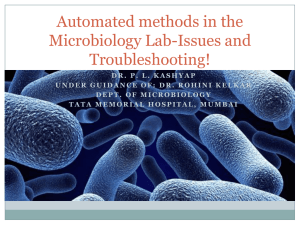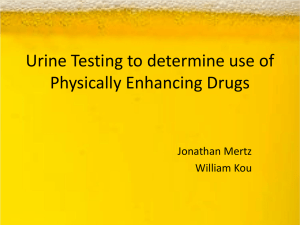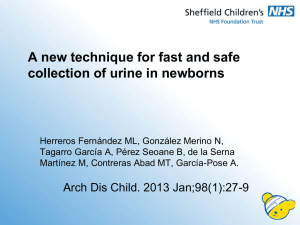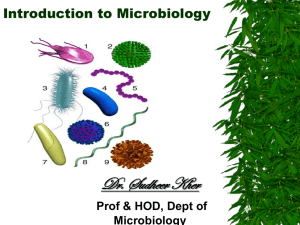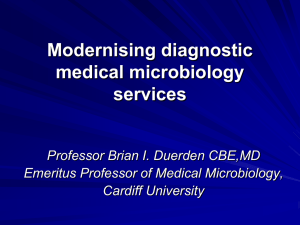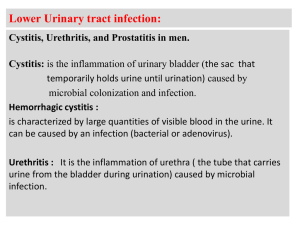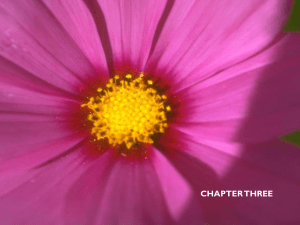URINARY TRACT INFECTIONS
advertisement
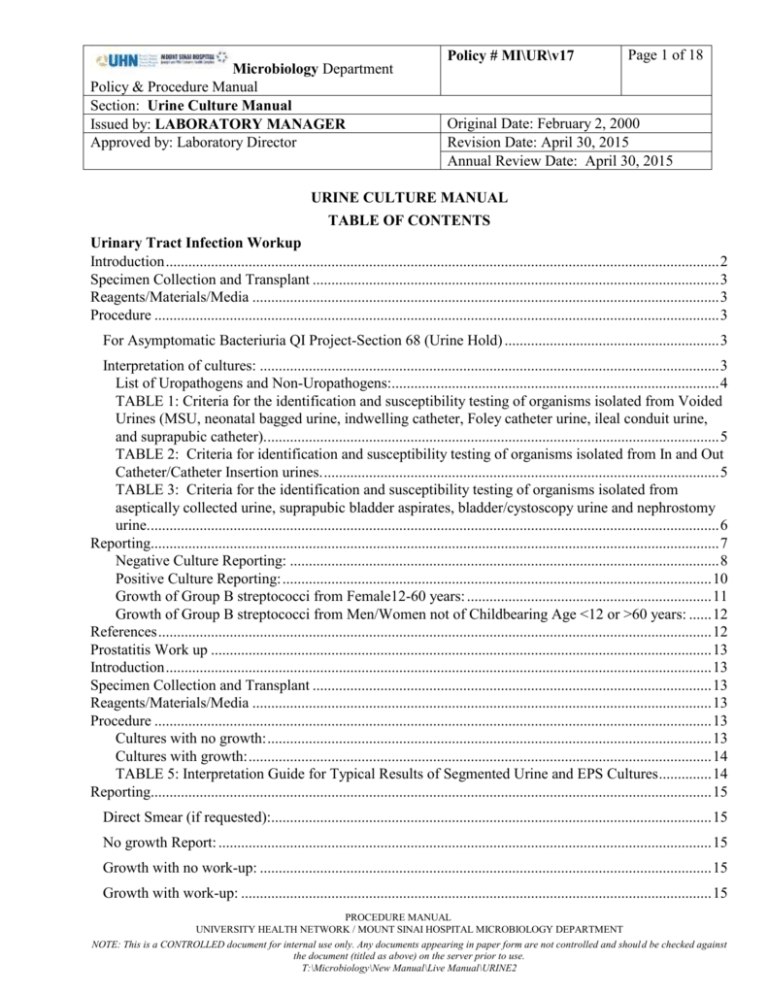
Policy # MI\UR\v17 Microbiology Department Policy & Procedure Manual Section: Urine Culture Manual Issued by: LABORATORY MANAGER Approved by: Laboratory Director Page 1 of 18 Original Date: February 2, 2000 Revision Date: April 30, 2015 Annual Review Date: April 30, 2015 URINE CULTURE MANUAL TABLE OF CONTENTS Urinary Tract Infection Workup Introduction ................................................................................................................................................... 2 Specimen Collection and Transplant ............................................................................................................ 3 Reagents/Materials/Media ............................................................................................................................ 3 Procedure ...................................................................................................................................................... 3 For Asymptomatic Bacteriuria QI Project-Section 68 (Urine Hold) ......................................................... 3 Interpretation of cultures: .......................................................................................................................... 3 List of Uropathogens and Non-Uropathogens:....................................................................................... 4 TABLE 1: Criteria for the identification and susceptibility testing of organisms isolated from Voided Urines (MSU, neonatal bagged urine, indwelling catheter, Foley catheter urine, ileal conduit urine, and suprapubic catheter)......................................................................................................................... 5 TABLE 2: Criteria for identification and susceptibility testing of organisms isolated from In and Out Catheter/Catheter Insertion urines. ......................................................................................................... 5 TABLE 3: Criteria for the identification and susceptibility testing of organisms isolated from aseptically collected urine, suprapubic bladder aspirates, bladder/cystoscopy urine and nephrostomy urine........................................................................................................................................................ 6 Reporting....................................................................................................................................................... 7 Negative Culture Reporting: .................................................................................................................. 8 Positive Culture Reporting: .................................................................................................................. 10 Growth of Group B streptococci from Female12-60 years: ................................................................. 11 Growth of Group B streptococci from Men/Women not of Childbearing Age <12 or >60 years: ...... 12 References ................................................................................................................................................... 12 Prostatitis Work up ..................................................................................................................................... 13 Introduction ................................................................................................................................................. 13 Specimen Collection and Transplant .......................................................................................................... 13 Reagents/Materials/Media .......................................................................................................................... 13 Procedure .................................................................................................................................................... 13 Cultures with no growth: ...................................................................................................................... 13 Cultures with growth: ........................................................................................................................... 14 TABLE 5: Interpretation Guide for Typical Results of Segmented Urine and EPS Cultures .............. 14 Reporting..................................................................................................................................................... 15 Direct Smear (if requested):..................................................................................................................... 15 No growth Report: ................................................................................................................................... 15 Growth with no work-up: ........................................................................................................................ 15 Growth with work-up: ............................................................................................................................. 15 PROCEDURE MANUAL UNIVERSITY HEALTH NETWORK / MOUNT SINAI HOSPITAL MICROBIOLOGY DEPARTMENT NOTE: This is a CONTROLLED document for internal use only. Any documents appearing in paper form are not controlled and shoul d be checked against the document (titled as above) on the server prior to use. T:\Microbiology\New Manual\Live Manual\URINE2 Microbiology Department Policy & Procedure Manual Section: Urine Culture Manual Policy # MI\UR\v16 Page 2 of 22 References ................................................................................................................................................... 16 Appendix I – Appearance of Common Uropathogens on CPS4 Agar ........................................................ 16 Gram negative bacteria: ........................................................................................................................... 16 Gram positive bacteria: ............................................................................................................................ 18 PROCEDURE MANUAL UNIVERSITY HEALTH NETWORK / MOUNT SINAI HOSPITAL MICROBIOLOGY DEPARTMENT NOTE: This is a CONTROLLED document for internal use only. Any documents appearing in paper form are not controlled and shoul d be checked against the document (titled as above) on the server prior to use. T:\Microbiology\New Manual\Live Manual\URINE2 Microbiology Department Policy & Procedure Manual Section: Urine Culture Manual Policy # MI\UR\v16 Page 2 of 22 Urinary Tract Infection Workup I. Introduction Urinary tract infections (UTI) are one of the most commonly encountered acute infectious diseases. Most UTIs occur as a result of bacteria ascending the urethra and entering the urinary bladder. Urine specimens for culture are collected when the following syndromes are suspected: cystitis, pyelonephritis, asymptomatic bacteriuria, and less commonly acute prostatitis, pyelonephric abscess, and urosepsis. Among the bacteria most commonly isolated from patients with acute uncomplicated cystitis are Escherichia coli, Klebsiella species, and other Enterobacteriaceae and Staphylococcus saprophyticus. Hospitalized patients and patients with complicated urinary tract infections are commonly infected with E. coli, Klebsiella species, Proteus mirabilis, other Enterobacteriaceae, Pseudomonas aeruginosa and enterococci. Corynebacterium urealyticum and Group B Streptococcus are markers of colonization in pregnant women. Urine specimens can be divided into categories based on clinical criteria, the possibility of urethral contamination, and the extent of microbiological work-up. For diagnosis of Urinary Tract Infection: - Voided urines (non-sterile): Midstream urine (MSU) Neonatal bagged urine Indwelling catheter (Foley catheter) urine Ileal conduit urine Suprapubic catheter urine - In and out catheter / catheter insertion urine - Aseptically collected urine: Nephrostomy urine Bladder/cystoscopy urine Suprapubic bladder aspirate For diagnosis of Prostatitis: - Segmented urine and expressed prostatic secretion (EPS). See Prostatitis Workup For diagnosis of Male infertility: - Seminal fluid. See Genital Manual Quantitative cultures of urine specimens are critical for diagnosis. The criteria to be used for distinguishing significant from non-significant growth may vary depending on the type of urine specimen received for culture. PROCEDURE MANUAL UNIVERSITY HEALTH NETWORK / MOUNT SINAI HOSPITAL MICROBIOLOGY DEPARTMENT NOTE: This is a CONTROLLED document for internal use only. Any documents appearing in paper form are not controlled and shoul d be checked against the document (titled as above) on the server prior to use. T:\Microbiology\New Manual\Live Manual\URINE2 Microbiology Department Policy & Procedure Manual Section: Urine Culture Manual Policy # MI\UR\v16 Page 3 of 22 Urine specimens arriving in the laboratory must be accessioned and processed as soon as possible. II. Specimen Collection and Transplant See Pre-analytical Procedure – Specimen Collection QPCMI02001 III. Reagents/Materials/Media See Analytical Process - Bacteriology Reagents/Materials/Media List QPCMI10001 IV. Procedure A. Processing of Specimens: See Specimen Processing Procedure QPCMI06003 a) Direct Examination: Gram stain: Not routinely performed. If specifically requested, perform Gram stain directly on unspun specimen. Fungal stain: Not routinely performed. If dimorphic fungus or cryptococcus specifically requested, see Mycology Manual for staining and interpretation. Eosinophil stain: Not routinely performed. If requested, stain slide and examine for the presence of eosinphils due to inter-tissue nephritis. b) Culture: For Asymptomatic Bacteriuria QI Project-Section 68 (Urine Hold) B. Interpretation of cultures: Examine plates after appropriate incubation time. a) Cultures with no growth: Discard no growth routine cultures after 18-24 hrs incubation. Except: - Urine specimens processed after 1600 hrs (plates from the “After 4 p.m.” basket) – reincubated until 1400 hrs and re-examine - Suprapubic urine – re-incubate for another 24hrs. - When yeast or non-specified fungus is requested – re-incubate for another 24 hrs at room temperature. - If colonies are too small – re-incubate for another 24hrs. PROCEDURE MANUAL UNIVERSITY HEALTH NETWORK / MOUNT SINAI HOSPITAL MICROBIOLOGY DEPARTMENT NOTE: This is a CONTROLLED document for internal use only. Any documents appearing in paper form are not controlled and shoul d be checked against the document (titled as above) on the server prior to use. T:\Microbiology\New Manual\Live Manual\URINE2 Microbiology Department Policy & Procedure Manual Section: Urine Culture Manual Policy # MI\UR\v16 Page 4 of 22 b) Cultures with growth: 1. Count the colonies and multiply by the appropriate dilution factor in SI units. Inoculation Loop size Colony count/L 0.001 mL 1 colony = 1 x 106 CFU/L 0.01 mL 1 colony = 0.1 x 106 CFU/L 2. Workup cultures according to the criteria in Tables 1, 2 and 3 below. The tables are meant to serve as a guide only. 3. Save Group B streptococcus isolates for 10 days at room temperature in case further susceptibility testing is required 4. Save positive yeast cultures for 10 days at room temperature in case further work-up is required. List of Uropathogens and Non-Uropathogens: Uropathogens Non-uropathogens (normal skin/urogenital flora) Enterobacteriaceae Lactobacillus Pseudomonas aeruginosa diphtheroids (not C. urealyticum) Other gram negative bacilli viridans Streptococci (not A. uriae) Enterococcus species Streptococcus anginosus group beta-haemolytic streptococci Streptococcus gallolyticus Yeast Bacillus species Aerococcus urinae* Corynebacterium urealyticum Staphylococcus aureus Staphylococcus saprophyticus - (females 12 - 60 yrs only) Other coagulase negative staphylococci (including Staphylococcus lugdenensis)* * Consider as uropathogens only when present in amounts >10-fold more than other non-uropathogens. PROCEDURE MANUAL UNIVERSITY HEALTH NETWORK / MOUNT SINAI HOSPITAL MICROBIOLOGY DEPARTMENT NOTE: This is a CONTROLLED document for internal use only. Any documents appearing in paper form are not controlled and shoul d be checked against the document (titled as above) on the server prior to use. T:\Microbiology\New Manual\Live Manual\URINE2 Microbiology Department Policy & Procedure Manual Section: Urine Culture Manual Policy # MI\UR\v16 Page 5 of 22 TABLE 1: Criteria for the identification and susceptibility testing of organisms isolated from Voided Urines (MSU, neonatal bagged urine, indwelling catheter, Foley catheter urine, ileal conduit urine, and suprapubic catheter). No. of Types of No. of colonies of each Colony count/L Work up for Report 1, 2, 3 Organisms type of uropathogens uropathogens 1 <10 <10 x 106 CFU/L No work-up No significant growth 6 1 >10 ID + Sens 10-100 x E6 cfu/L 10 x 10 CFU/L 2 Both >100 >100 x 106 CFU/L ID + Sens on both >100 x E6 cfu/L 2 >100 x 106 CFU/L <100 x 106 CFU/L <100 x106 CFU/L ID + Sens Ignore No work-up >100 x E6 cfu/L 2 One >100 One <100 Both <100 3 All uropathogens <100 No work-up No work-up Any uropathogen >100 3 ID = Identification; Sens = Susceptibility testing as appropriate Note: 1. When counting the types of organisms, do not include <10 colonies of non-uropathogens. 2. 3. No significant growth No significant growth Mixed growth Do not workup or report any number of colonies of non-uropathogens For female ages 12-60 yrs, workup any amount of beta-haemolytic streptococcus to rule out Group B streptococcus. (Reporting – follow Reporting Table for GBS) TABLE 2: Criteria for identification and susceptibility testing of organisms isolated from In and Out Catheter/Catheter Insertion urines. No. of Types of No. of colonies of each Colony count/L Work-up for Report Organisms 1, 2, 3 type of uropathogens uropathogens 1 <10 <10 x 106 CFU/L No work-up No significant growth 6 1 >10 ID + Sens 10-100 x E6 cfu/L or 10 x 10 CFU/L >100 x E6 cfu/L 2 Both >10 ID + Sens 10-100 x E6 cfu/L or 10 x 106 CFU/L >100 x E6 cfu/L 6 2 One >10 ID + Sens 10-100 x E6 cfu/L or 10 x 10 /L >100 x E6 cfu/L One <10 or factor of 10x less Use phrase - Light growth -on LIS TEST Comment Describe4 PROCEDURE MANUAL UNIVERSITY HEALTH NETWORK / MOUNT SINAI HOSPITAL MICROBIOLOGY DEPARTMENT NOTE: This is a CONTROLLED document for internal use only. Any documents appearing in paper form are not controlled and shoul d be checked against the document (titled as above) on the server prior to use. T:\Microbiology\New Manual\Live Manual\URINE2 Policy # MI\UR\v16 Microbiology Department Policy & Procedure Manual Section: Urine Culture Manual No. of Types of Organisms 1, 2, 3 No. of colonies of each type 3 >10 Other(s) <10 or factor of 10x less Colony count/L of uropathogens (do not enter as ISOLATE) >10 x 106 CFU/L Page 6 of 22 Work-up for uropathogens Report ID + Sens 10-100 x E6 cfu/L or 10-100 x E6 cfu/L Describe4 Use phrase - Light growth -on LIS TEST Comment (do not enter as ISOLATE) 4 All uropathogens <10 No work-up 4 Any uropathogen >10 No work-up No significant growth Mixed growth ID = Identification; Sens = Susceptibility testing as appropriate Note: 1. When counting the types of organisms, do not include <10 colonies of non-uropathogens. 2. Do not workup or report any number of colonies of non-uropathogens. 3. For female ages 12-60 yrs, workup any amount of beta-haemolytic streptococcus to rule out Group B streptococcus. (Reporting – follow Reporting Table for GBS) 4. Describe as Gram positive cocci, Gram positive bacilli, Gram negative bacilli. TABLE 3: Criteria for the identification and susceptibility testing of organisms isolated from aseptically collected urine, suprapubic bladder aspirates, bladder/cystoscopy urine and nephrostomy urine. No. of Types of Organisms Any # No. of colonies of each type Any Colony count/ L Work-up Quantitate using appropriate dilution factor ID; Sens Inoculation Loop size Colony count/L 0.001 mL 0.01 mL 1 colony = 1 x 106 CFU/L 1 colony = 0.1 x 106 CFU/L ID = Identification; Sens = Susceptibility testing as appropriate C. Susceptibility Testing: Refer to Susceptibility Testing Manual PROCEDURE MANUAL UNIVERSITY HEALTH NETWORK / MOUNT SINAI HOSPITAL MICROBIOLOGY DEPARTMENT NOTE: This is a CONTROLLED document for internal use only. Any documents appearing in paper form are not controlled and shoul d be checked against the document (titled as above) on the server prior to use. T:\Microbiology\New Manual\Live Manual\URINE2 Microbiology Department Policy & Procedure Manual Section: Urine Culture Manual V. Policy # MI\UR\v16 Page 7 of 22 Reporting Direct Smear (if requested): Gram Stain: “(No) Pus cells seen. (No) Bacteria seen” (without quantitation) Eosinophil Stain: Negative report: “No Eosinophil seen” Positive report: “Eosinophils present” PROCEDURE MANUAL UNIVERSITY HEALTH NETWORK / MOUNT SINAI HOSPITAL MICROBIOLOGY DEPARTMENT NOTE: This is a CONTROLLED document for internal use only. Any documents appearing in paper form are not controlled and shoul d be checked against the document (titled as above) on the server prior to use. T:\Microbiology\New Manual\Live Manual\URINE2 Microbiology Department Policy & Procedure Manual Section: Urine Culture Manual Policy # MI\UR\v16 Page 8 of 22 Negative Culture Reporting: Result Category C&S “No growth” No growth No significant growth Growth with no workup “No significant growth” (pick from TEST window keypad - }NSG) C&S + routine fungus requested and no FUNGUS test ordered “No growth. Routine urine fungal cultures screen for significant growth of yeast only. Filamentous fungi will not be ruled out unless a specific request is made” (pick from TEST window keypad - }NGU). “No significant growth. Routine urine fungal cultures screen for significant growth of yeast only. Filamentous fungi will not be ruled out unless a specific request is made.” (pick from TEST window keypad - }NSGU) Reporting C&S + routine fungus requested and FUNGUS test ordered C&S TEST - “No growth” Fungus TEST - “No growth. Routine urine fungal cultures screen for significant growth of yeast only. Filamentous fungi will not be ruled out unless a specific request is made” (pick from TEST window keypad - }NGU) C&S TEST - “No significant growth. Routine urine fungal cultures screen for significant growth of yeast only. Filamentous fungi will not be ruled out unless a specific request is made.” (pick from TEST window keypad - }NSGU) Fungus TEST - “No significant growth. Routine urine fungal cultures screen for significant growth of yeast only. Filamentous fungi will not be ruled out unless a specific request is made.” (pick from TEST window keypad - }NSGU) Cryptococcus or specific filamentous fungus requested C&S TEST - “No growth” Fungus TEST – as per Mycology manual. C&S TEST - “No significant growth” (pick from TEST window keypad }NSG) Fungus TEST - as per Mycology manual. PROCEDURE MANUAL UNIVERSITY HEALTH NETWORK / MOUNT SINAI HOSPITAL MICROBIOLOGY DEPARTMENT NOTE: This is a CONTROLLED document for internal use only. Any documents appearing in paper form are not controlled and shoul d be checked against the document (titled as above) on the server prior to use. T:\Microbiology\New Manual\Live Manual\URINE2 Microbiology Department Policy & Procedure Manual Section: Urine Culture Manual Result Category Page 9 of 22 Reporting C&S Mixed growth Policy # MI\UR\v16 “Mixed growth. Suggest repeat specimen if patient’s symptoms suggest a urinary tract infection.” (Pick from LIS TEST window keypad “Mixed }MIXG”) C&S + routine fungus requested and no FUNGUS test ordered “Mixed growth. Suggest repeat specimen if patient’s symptoms suggest a urinary tract infection.” (Pick from LIS TEST window keypad “Mixed }MIXG”) C&S + routine fungus requested and FUNGUS test ordered C&S TEST - “Mixed growth. Suggest repeat specimen if patient’s symptoms suggest a urinary tract infection.” (Pick from LIS TEST window keypad “Mixed }MIXG”) Fungus TEST - “Mixed growth. Suggest repeat specimen if patient’s symptoms suggest a urinary tract infection.” (Pick from LIS TEST window keypad “Mixed }MIXG”) Cryptococcus or specific filamentous fungus requested C&S TEST - “Mixed growth. Suggest repeat specimen if patient’s symptoms suggest a urinary tract infection.” (Pick from LIS TEST window keypad “Mixed }MIXG”) Fungus TEST - as per Mycology manual. PROCEDURE MANUAL UNIVERSITY HEALTH NETWORK / MOUNT SINAI HOSPITAL MICROBIOLOGY DEPARTMENT NOTE: This is a CONTROLLED document for internal use only. Any documents appearing in paper form are not controlled and shoul d be checked against the document (titled as above) on the server prior to use. T:\Microbiology\New Manual\Live Manual\URINE2 Microbiology Department Policy & Procedure Manual Section: Urine Culture Manual Policy # MI\UR\v16 Page 10 of 22 Positive Culture Reporting: Result Category Reporting C&S Growth with workup Preliminary report Growth with workup Final report C&S + routine fungus C&S + routine fungus requested and Cryptococcus or specific requested and no FUNGUS test ordered filamentous fungus FUNGUS test ordered requested Morphologic description of organism with corresponding colony count/L - choose from LIS ISOLATE window keypad: \<=10 for <10 x E6 cfu/L, \<100 for 10-100 x E6 cfu/L, \>100 for >100 x E6 cfu/L. Organism name Organism name with C&S TEST - Organism name with C&S TEST - Organism with corresponding corresponding colony corresponding colony count/L (choose name with corresponding colony count/ count/L (choose from LIS from LIS ISOLATE window keypad as colony count/L (choose L (choose from ISOLATE window above) and susceptibility testing results. from LIS ISOLATE LIS ISOLATE keypad as above) and window keypad as above) Add “No significant yeast isolated. window keypad as susceptibility testing and susceptibility testing Routine urine fungal cultures screen for above) and results. results. significant growth of yeast only. susceptibility Add “No significant Filamentous fungi will not be ruled out testing results. yeast isolated. Routine unless a specific request is made.”(pick urine fungal cultures from TEST window keypad - }NYSU) screen for significant Fungus TEST - (pick from TEST Fungus TEST - as per growth of yeast only. Mycology manual. window keypad - }NYSU) as above Filamentous fungi will not be ruled out unless a specific request is made.”(pick from TEST window keypad }NYSU) PROCEDURE MANUAL UNIVERSITY HEALTH NETWORK / MOUNT SINAI HOSPITAL MICROBIOLOGY DEPARTMENT NOTE: This is a CONTROLLED document for internal use only. Any documents appearing in paper form are not controlled and shoul d be checked against the document (titled as above) on the server prior to use. T:\Microbiology\New Manual\Live Manual\URINE2 Microbiology Department Policy & Procedure Manual Section: Urine Culture Manual Policy # MI\UR\v16 Page 11 of 22 Growth of Group B streptococci from Female12-60 years: Result Category Reporting Report as Isolate with corresponding colony count/L. Add ISOLATE Comment “This organism is intrinsically susceptible to penicillin. If treatment is required AND this patient cannot be treated Significant amount with penicillin, empiric treatment with nitrofurantoin or levofloxacin is generally successful for bacteriuria. If advice regarding antimicrobial treatment is desired, please contact the medical microbiologist on-call. NOTE REGARDING PREGNANT PATIENTS: Any women with GBS bacteriuria in any concentration during her pregnancy should also receive intrapartum chemoprophylaxis. Reference: J Obs Gyn Can 2004; 26(9):826-32. If this patient is pregnant AND cannot be treated with penicillin, please contact the Microbiology Department within 48 hours for susceptibility tests to help guide intrapartum chemoprophylaxis.” (Pick from LIS ISOLATE window keypad “\GBSU for female 12-60y”) Report TEST Comment: “Group B streptococcus isolated but in amounts too small to suggest a GBS urinary tract infection. However, any woman with GBS bacteriuria in any concentration during Non-significant amount her pregnancy should receive intrapartum chemoprophylaxis. Reference: J Obs Gyn Can 2004; 26(9):826-32. This organism is intrinsically susceptible to penicillin. If this patient is pregnant AND cannot be treated with penicillin, please contact the Microbiology Department within 48 hours to request susceptibility testing.” (Pick from LIS TEST window keypad “Group B }GBsm”) “Mixed growth, including Group B streptococcus (GBS). Suggest repeat specimen if patient’s symptoms suggest a urinary tract infection. Any women with GBS bacteriuria during her pregnancy, Mixed growth with GBS even in mixed growth, should receive intrapartum chemoprophylaxis. Reference: J Obs Gyn Can 2004; 26(9):826-32. This organism is intrinsically susceptible to penicillin. If this patient is pregnant AND cannot be treated with penicillin, please contact the Microbiology Department within 48 hours to request susceptibility testing.” (Pick from LIS TEST window “Mixed }wGBS”) PROCEDURE MANUAL UNIVERSITY HEALTH NETWORK / MOUNT SINAI HOSPITAL MICROBIOLOGY DEPARTMENT NOTE: This is a CONTROLLED document for internal use only. Any documents appearing in paper form are not controlled and shoul d be checked against the document (titled as above) on the server prior to use. T:\Microbiology\New Manual\Live Manual\URINE2 Microbiology Department Policy & Procedure Manual Section: Urine Culture Manual Policy # MI\UR\v16 Page 12 of 22 Growth of Group B streptococci from Men/Women not of Childbearing Age <12 or >60 years: Result Category Significant amount VI. Reporting Report as Isolate with corresponding colony count/L. Add ISOLATE Comment “This organism is intrinsically susceptible to penicillin. If treatment is required AND this patient cannot be treated with penicillin, empiric treatment with nitrofurantoin or levofloxacin is generally successful for bacteriuria. If advice regarding antimicrobial treatment is desired, please contact the medical microbiologist on-call.” (Pick from LIS ISOLATE window keypad “\GBS” ) References Murray P.R., Baron E.J., Pfaller M.A., Yolken R.H.. 2003. Manual of Clinical Microbiology, 8th ed. ASM Press, Washington, D.C. Izenberg H.D.. 2003. Urine Cultures, 3.12.1 in Clinical Microbiology Procedures Handbook, 2nd ed. Vol.1 ASM Press, Washington, D.C. Burd, E.M., Hall, G.S., McCarter, Y.S., Zervos, M. 2009. Cumitech 2C, Laboratory Diagnosis of Urinary Tract Infections, Coordinating ed., A.S. Weissfield. ASM, Washington, D.C. PROCEDURE MANUAL UNIVERSITY HEALTH NETWORK / MOUNT SINAI HOSPITAL MICROBIOLOGY DEPARTMENT NOTE: This is a CONTROLLED document for internal use only. Any documents appearing in paper form are not controlled and shoul d be checked against the document (titled as above) on the server prior to use. T:\Microbiology\New Manual\Live Manual\URINE2 Microbiology Department Policy & Procedure Manual Section: Urine Culture Manual Policy # MI\UR\v16 Page 13 of 22 Prostatitis Work up I. Introduction Bacterial cultures of segmented lower urinary tract specimens can be used to differentiate urethritis/cystitis and prostatitis depending on the different quantitation of growth in the different segmented specimens. Segmented quantitation culture specimens include initial stream sample of urine (VB1), a midstream urine sample (VB2), an aliquot of expressed prostatic secretion (EPS) and a post prostatic massage secretion (VB3). When seminal fluid is sent with VB1, 2 or 3, it should be treated as EPS. Occasionally, only a pre-massage (VB1 or VB2) and post-massage (VB3) urine specimen will be received. II. Specimen Collection and Transplant See Pre-analytical Procedure – Specimen Collection QPCMI02001 III. Reagents/Materials/Media See Analytical Process - Bacteriology Reagents/Materials/Media List QPCMI10001 IV. Procedure A. Processing of Specimens: See Specimen Processing Procedure QPCMI06003 a) Direct Examination: Gram stain: Not routinely performed. If specifically requested, perform Gram stain directly on unspun specimen. B. Interpretation of cultures: Examine plates after appropriate incubation time. a) Cultures with no growth: PROCEDURE MANUAL UNIVERSITY HEALTH NETWORK / MOUNT SINAI HOSPITAL MICROBIOLOGY DEPARTMENT NOTE: This is a CONTROLLED document for internal use only. Any documents appearing in paper form are not controlled and shoul d be checked against the document (titled as above) on the server prior to use. T:\Microbiology\New Manual\Live Manual\URINE2 Microbiology Department Policy & Procedure Manual Section: Urine Culture Manual Policy # MI\UR\v16 Page 14 of 22 Discard no growth routine cultures after 18-24 hrs incubation. Except: - Urine specimens processed after 1600 hrs (plates from the “After 4 p.m.” basket) – reincubated until 1400 hrs and re-examine - When yeast or non-specified fungus is requested – re-incubate for another 24 hrs at room temperature. - If colonies are too small – re-incubate for another 24hrs. b) Cultures with growth: 1. For each plate, count the colonies and multiply by the appropriate dilution factor in SI units. 2. Workup cultures according to the criteria in Tables 4. TABLE 4: Segmented Urine and Expressed Prostatic Secretion (EPS) Inoculation Loop size Colony count/L Work-up Uropathogens: Quantitate, ID + susceptibility 0.001 mL 1 colony = 1 x 106 CFU/L 0.01 mL 1 colony = 0.1 x 106 CFU/L Non-uropathogens: Quantitate, minimal workup for ID (no susceptibility) Note: Consider coagulase-negative staphylococcus as uropathogens only when present in amounts >10fold more that other non-uropathogens. See Identification and Susceptibility Testing Methods for Common Urinary Tract Isolates for workup. TABLE 5: Interpretation Guide for Typical Results of Segmented Urine and EPS Cultures Pre-massage samples Prostatic massage sample Post-massage sample Possible Diagnosis VB1 VB2 EPS VB3 + Prostatitis + + Prostatitis + + + + Cystitis+Prostatitis + + ++ (10 fold >VB2) Cystitis+Prostatitis + + + Urethritis/Cystitis + Contamination No infection + = growth of the same isolate type in each sample C. Susceptibility Testing: PROCEDURE MANUAL UNIVERSITY HEALTH NETWORK / MOUNT SINAI HOSPITAL MICROBIOLOGY DEPARTMENT NOTE: This is a CONTROLLED document for internal use only. Any documents appearing in paper form are not controlled and shoul d be checked against the document (titled as above) on the server prior to use. T:\Microbiology\New Manual\Live Manual\URINE2 Microbiology Department Policy & Procedure Manual Section: Urine Culture Manual Policy # MI\UR\v16 Page 15 of 22 Refer to Susceptibility Testing Manual V. Reporting Segmented Urine and Expressed Prostatic Secretion for diagnosis of Prostatitis: Direct Smear (if requested): Gram Stain: “(No) Pus cells seen. (No) Bacteria seen” (without quantitation) Culture: No growth Report: “No Growth” Growth Report: Growth with no work-up: Report as TEST Comment “highest colony count - choose from LIS TEST window keypad: }<1 for <1 x E6 cfu/L, }<10 for 1-9 x E6 cfu/L, }<100 for 10-100 x E6 cfu/L, }>100 for >100 x E6 cfu/L and Skin/Urethral Flora” Growth with work-up: Organism name with corresponding (highest colony count choose from LIS ISOLATE window keypad: \<1 for <1 x E6 cfu/L, \<10 for 1-9 x E6 cfu/L, \<100 for 10-100 x E6 cfu/L, \>100 for >100 x E6 cfu/L) and appropriate susceptibility testing results. PROCEDURE MANUAL UNIVERSITY HEALTH NETWORK / MOUNT SINAI HOSPITAL MICROBIOLOGY DEPARTMENT NOTE: This is a CONTROLLED document for internal use only. Any documents appearing in paper form are not controlled and shoul d be checked against the document (titled as above) on the server prior to use. T:\Microbiology\New Manual\Live Manual\URINE2 Microbiology Department Policy & Procedure Manual Section: Urine Culture Manual VI. Page 16 of 22 References VII. Policy # MI\UR\v16 Murray P.R., Baron E.J., Pfaller M.A., Yolken R.H. 2003. Manual of Clinical Microbiology, 8th ed. ASM Press, Washington, D.C. Izenberg H.D. 2003. Urine Cultures, 3.12.1 in Clinical Microbiology Procedures Handbook, 2nd ed. Vol.1 ASM Press, Washington, D.C. Burd, E.M., Hall, G.S., McCarter, Y.S., Zervos, M. 2009. Cumitech 2C, Laboratory Diagnosis of Urinary Tract Infections, Coordinating ed., A.S. Weissfield. ASM, Washington, D.C. Meares E.M. Investigative Urology 1968. 5(5):492-518 Nickel J.C. Techniques in Urology 1997. 3(10):38-43. Appendix I – Appearance of Common Uropathogens on CPS4 Agar Gram negative bacteria: Figure 1: Left – NLF E.coli, Right – LF E.coli Both display burgundy/pink colonies on CPS4. No growth on CNA. Visual E.coli identification acceptable. No MS needed. Requires antimicrobial sensitivities if of significant amount. PROCEDURE MANUAL UNIVERSITY HEALTH NETWORK / MOUNT SINAI HOSPITAL MICROBIOLOGY DEPARTMENT NOTE: This is a CONTROLLED document for internal use only. Any documents appearing in paper form are not controlled and shoul d be checked against the document (titled as above) on the server prior to use. T:\Microbiology\New Manual\Live Manual\URINE2 Microbiology Department Policy & Procedure Manual Section: Urine Culture Manual Policy # MI\UR\v16 Page 17 of 22 Figure 2: Left and Right – K. pneumoniae Klebsiella, Enterobacter, Citrobacter display blue/green colonies on CPS4. No growth on CNA. Requires Vitek MS identification and antimicrobial sensitivities if of significant amount. Figure 3: Left – P. aeruginosa, Right – mucoid P. aeruginosa: Display brown/beige colonies on CPS4. No growth on CNA. Requires Vitek MS identification and antimicrobial sensitivities if of significant amount. PROCEDURE MANUAL UNIVERSITY HEALTH NETWORK / MOUNT SINAI HOSPITAL MICROBIOLOGY DEPARTMENT NOTE: This is a CONTROLLED document for internal use only. Any documents appearing in paper form are not controlled and shoul d be checked against the document (titled as above) on the server prior to use. T:\Microbiology\New Manual\Live Manual\URINE2 Microbiology Department Policy & Procedure Manual Section: Urine Culture Manual Policy # MI\UR\v16 Page 18 of 22 Gram positive bacteria: Figure 4: Staphylococcus species Display colourless colonies on CPS4. Growth on CNA. Requires Vitek MS identification and antimicrobial sensitivities as required. Figure 5: Enterococcus species Display blue colonies on CPS4. Growth on CNA. Requires Vitek MS identification and antimicrobial sensitivities. PROCEDURE MANUAL UNIVERSITY HEALTH NETWORK / MOUNT SINAI HOSPITAL MICROBIOLOGY DEPARTMENT NOTE: This is a CONTROLLED document for internal use only. Any documents appearing in paper form are not controlled and shoul d be checked against the document (titled as above) on the server prior to use. T:\Microbiology\New Manual\Live Manual\URINE2 Microbiology Department Policy & Procedure Manual Section: Urine Culture Manual Policy # MI\UR\v16 Page 19 of 22 Figure 6: Beta-hemolytic streptococcus: Display violet, blue or colourless colonies on CPS4. Growth on CNA with hemolysis. Requires Vitek MS identification and antimicrobial sensitivities if requested. PROCEDURE MANUAL UNIVERSITY HEALTH NETWORK / MOUNT SINAI HOSPITAL MICROBIOLOGY DEPARTMENT NOTE: This is a CONTROLLED document for internal use only. Any documents appearing in paper form are not controlled and shoul d be checked against the document (titled as above) on the server prior to use. T:\Microbiology\New Manual\Live Manual\URINE2 Policy # MI\UR\02\v17 Page 20 of 22 Microbiology Department Policy & Procedure Manual Urine Culture Manual Record of Edited Revisions Manual Section Name: Urine Bench Manual Page Number / Item Annual Review Annual Review Annual Review Specimen collection procedure – see Pre-analytical Procedure - Specimen Collection QPCMI02001 Specimen processing procedure - See Specimen Processing Procedure QPCMI06003 Modify urine category page 2 Removed Specimen Rejection Criteria; refer to Specimen Rejection Criteria QPCMI06001 Modified Interpretation of Culture wording Page 3 C. urealyticum and A. uriae added to the ID table Page 6 New Reporting category and phrases Page 7, 8 New Table of Contents page New section and workup table for segmented urine and EPS Work-up any amount of beta-haemolytic strep to rule out GBS in females 12-60 years. Report >3 types of uropathogens as “mixed growth…..” Urine Reporting Prostatitis Workup Reporting Urine interpretation tables 1 and 2 – modified “mixed growth” Modified Urine “mixed growth” reporting phrase Annual Review Annual Review Annual Review Annual Review GBS reporting phrases Suprapubic/Asceptically collected urine processing to 10uL and 100uL loops Annual Review Annual Review Annual Review Date of Revision May 26, 2004 May 12, 2005 April 10, 2006 April 10, 2006 Signature of Approval Dr. T. Mazzulli Dr. T. Mazzulli Dr. T. Mazzulli Dr. T. Mazzulli April 10, 2006 Dr. T. Mazzulli April 10, 2006 April 10, 2006 Dr. T. Mazzulli Dr. T. Mazzulli April 10, 2006 April 10, 2006 April 10, 2006 April 10, 2006 April 10, 2006 Dr. T. Mazzulli Dr. T. Mazzulli Dr. T. Mazzulli Dr. T. Mazzulli Dr. T. Mazzulli April 10, 2006 Dr. T. Mazzulli April 10, 2006 August 03, 2006 August 03, 2006 September 14, 2006 Dr. T. Mazzulli Dr. T. Mazzulli Dr. T. Mazzulli Dr. T. Mazzulli September 14, 2006 August 13, 2007 August 15, 2008 August 10, 2009 June 18, 2010 June 18, 2010 June 18, 2010 Dr. T. Mazzulli Dr. T. Mazzulli Dr. T. Mazzulli Dr. T. Mazzulli Dr. T. Mazzulli Dr. T. Mazzulli Dr. T. Mazzulli June 20, 2011 June 30, 2012 August 25, 2013 Dr. T. Mazzulli Dr. T. Mazzulli Dr. T. Mazzulli PROCEDURE MANUAL UNIVERSITY HEALTH NETWORK / MOUNT SINAI HOSPITAL MICROBIOLOGY DEPARTMENT NOTE: This is a CONTROLLED document for internal use only. Any documents appearing in paper form are not controlled and shoul d be checked against the document (titled as above) on the server prior to use. T:\Microbiology\New Manual\Live Manual\URINE2 Policy # MI\UR\02\v17 Page 21 of 22 Microbiology Department Policy & Procedure Manual Urine Culture Manual Page Number / Item Modify Headers Modify Table of Contents Annual Review Add on Streptococcus anginosus group and Streptococcus gallolyticus as non-uropathognes Addition of Appendix 1 Addition of link Urine Hold to work up Date of Revision June 11, 2014 Signature of Approval Dr. T. Mazzulli December 23, 2014 Dr. T. Mazzulli February 1, 2015 April 30, 2015 Dr. T. Mazzulli Dr. T. Mazzulli PROCEDURE MANUAL UNIVERSITY HEALTH NETWORK / MOUNT SINAI HOSPITAL MICROBIOLOGY DEPARTMENT NOTE: This is a CONTROLLED document for internal use only. Any documents appearing in paper form are not controlled and shoul d be checked against the document (titled as above) on the server prior to use. T:\Microbiology\New Manual\Live Manual\URINE2

